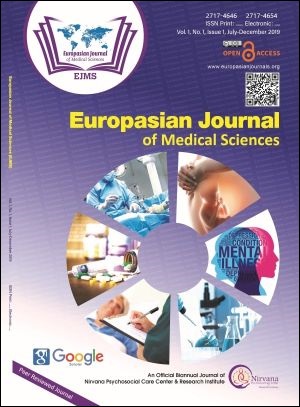Morphometric Study of Hyoid Bone and its Forensic Implication
Keywords:
Anthropometry, Comu, Sexual dimorphism, OsteometryAbstract
Background: Hyoid bone, the bone of the anterior midline of the neck, is significant in forensic medicine as it presents the sexual dimorphism. The main aim of this study was to assess the morphometry of hyoid bone and its relationship with sex and height of an individual.
Methods: This was a cross-sectional study, conducted on 60 hyoid bones (36 male and 24 female) in the Department of Anatomy from the year 2013 to 2016 AD. The ethical approval was taken from the department. The 12 major anthropometric measurements were taken on each hyoid bone using a digital Vernier Caliper, and electronic weighing machine.
Result: Total of 60 hyoid bones were studied in this study, out of which 36(60%) were male. The average measurements of all 12 major parameters of the hyoid bone were found to be significantly greater in male than in female. Moreover, the length of the cadaver (height) had significant correlation with the vertical breadth and transverse length of the body of hyoid bone. The average length of right greater cornu in male and females were 32.78+2.44 mm and 28.89+2.47 mm respectively. The width of the body of the hyoid bone in the midline in male and female were 22.51+3.73 mm and 20.27+1.75 mm respectively. The antero-posterior thickness of the body in male and female were 5.66+0.97 mm and 6.45+1.79 mm respectively. It was also observed that the hyoid bone was heavier in male (1.858+0.433gm) than in females (1.261+0.102gm).
Conclusion: All the anthropometric measurements of hyoid bone were significantly greater in males than in females. Moreover, the height of the person had strong positive correlation with the vertical breadth and transverse length of the body of the hyoid bone. These findings can be used for forensic investigation as well as archeological studies. with high degree of accuracy for the purpose of sex identification.
Downloads
Downloads
Published
How to Cite
Issue
Section
License
The author(s) retain the ownership of the copyrights for their work published in EJMS without any restrictions. Upon submission, the author(s) grants EJMS a license to publish, including to display, store, copy, and reuse the published content.
License to Publish
By submitting a manuscript to EJMS, the author(s) grant the journal a non-exclusive license to:
- Publish and distribute the content in all formats, media, and platforms (both existing and future), while identifying EJMS as the original publisher.
- Reproduce, display, and store the content in both print and online formats, including institutional and digital repositories.
- Translate, adapt, and summarize the work, including reprints, extracts, and abstracts.
- Develop derivative works based on the original content.
- Include the work in electronic databases and provide links to third-party materials.
Creative Commons Licensing
In addition to EJMS’s publishing rights, authors grant third parties the right to use, share, and distribute their work under the Creative Commons Attribution 4.0 (CC BY 4.0) International License. This allows unrestricted use of the content, provided proper attribution is given to the original author(s) and the journal.

